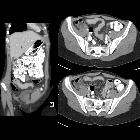linitis plastica


















Linitis plastica is a descriptive term usually referring to the appearance of the stomach, although the rectum can also be described this way. The appearance is said to be reminiscent of an old leather water-bottle.
Pathology
The underlying cause is usually a scirrhous adenocarcinoma with diffuse submucosal infiltration, leading to thickening and rigidity to the stomach wall .
It is important to realize that as the infiltration is submucosal, gastric biopsies are frequently negative .
Radiographic features
Fluoroscopy
During a barium meal, the stomach cannot be adequately distended due to the increased rigidity of the wall with only a narrow lumen identified. The normal mucosal fold pattern is absent, either distorted, thickened, or nodular .
CT
Typically the stomach is diffusely thickened with a small lumen. Evidence of nodal involvement or widespread metastatic disease should also be sought.
Differential diagnosis
Whether you define linitis plastica as only the appearance of the stomach, irrespective of cause or use it only in the setting of infiltrating adenocarcinoma of the stomach is up to you, but be aware that there does not appear to be general agreement. Thus the cause of linitis plastica are also the differential, and include :
- neoplastic
- gastric adenocarcinoma (scirrhous)
- lymphoma: less rigid
- diffuse gastric diverticula (rare)
- inflammatory
- radiotherapy
- eosinophilic enteritis
- granulomatous disease
- scarring (e.g. ingestion of corrosives)
- gastric amyloidosis
History and etymology
Etymology: linitis means inflammatory change, plastica means inelastic, not pliable.
The term was coined by William Brinton (1823-1867) in 1854. Hence the disease is also unsurprisingly called Brinton disease.
Siehe auch:
und weiter:

 Assoziationen und Differentialdiagnosen zu szirrhöses Magenkarzinom:
Assoziationen und Differentialdiagnosen zu szirrhöses Magenkarzinom:




